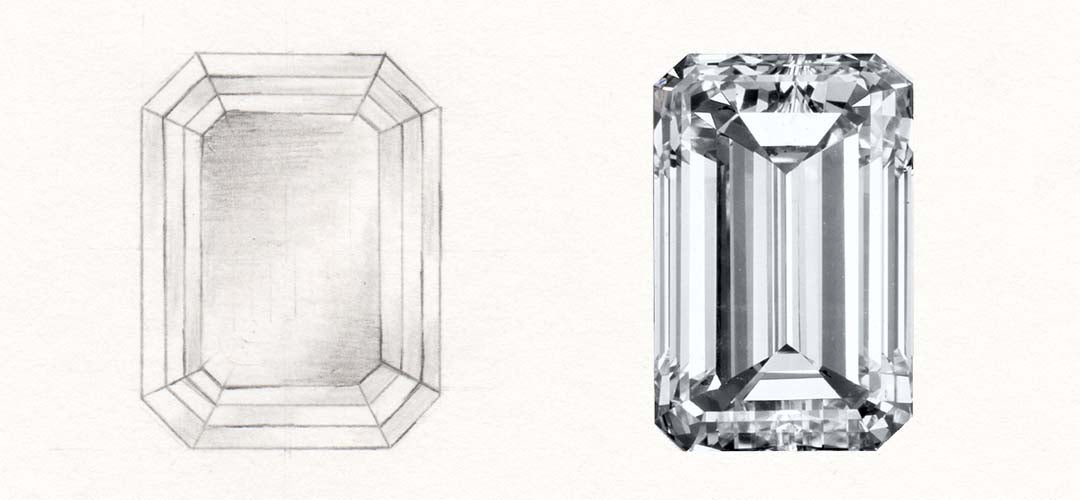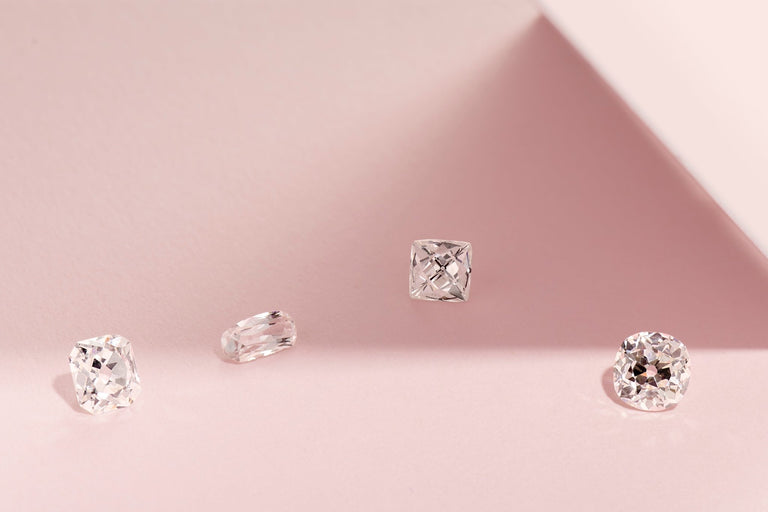The history of diamond cutting officially began in the middle ages when diamonds became fashionable in Europe. This diagram illustrates the six most popular antique diamond cuts throughout history.
1300 Early Point Cuts
The very first diamonds were found in India and kept as loose unpolished stones. They were considered sacred objects that were believed to have possessed magical powers. Not until the 11th century were diamonds worn in jewelry but still in an uncut form. Initial diamond cutting began in the 14th century but at that time it was likely very superficial type of polishing of the stone in order to give it some shine. Initially there was the point cut, which followed the natural shape of the diamond. Diamonds were very rare and were only worn by kings and queens.
1400 Point & Table Cuts
The table cut was the first major faceting technique to be used. Followed by the step cut. The precursor to the emerald cut diamond, which wouldn’t be called that until the 1940s. It was during the 15th century that it was discovered that diamonds could be cut by their own dust!
In 1477 Mary of Burgundy became the first to receive a diamond engagement ring which was gifted to her by Archduke Maximilian of Austria. The ring was set with a point cut diamond and thin flat pieces of diamonds in the shape of an “M”. It is likely that the tradition of the diamond engagement ring really began with this event.
1500 Early Rose Cuts
In the 16th century tools were invented to cut facets into diamonds. The rose cut and transition cut were added to the diamond cutter’s repertoire. It was at this time that early bruting, faceting, and polishing of diamonds began to be used by European cutters.
Until this time most of the diamond trade took place in India. As cutting techniques matured, diamonds began to take on a new perception and demand grew but they were still rare and would continue to be until the discovery of African mines in the late 19th century.
With just 24 facets, the subtle beauty of rose cut diamonds is that they impart a soft diffused light rather then the bright light of the modern brilliant cut. The most significant trait of rose cut diamonds is that they are flat at the bottom and dome shaped at the top. Unlike other diamonds which have culets and tables.

1700 Rose & Rise of Old Mine Cushion Cuts
The early 18th century saw a rise of diamond production in Brazil and the coming of new rounded or cushion shaped diamonds. The most significant being the old mine cushion.
Old mine cut diamonds, also known as a cushion cuts, are basically the great-grandfathers of modern brilliant cuts. Developed in 18th century Europe, these cuts were not round but had a slightly curved edge which formed a soft square. They were made with a variety of facet patterns but always with a small table, high crown, and larger culet, giving them an architectural look.

Diamonds continued to be rare during the Georgian era and only worn by aristocracy. In the mid 18th century King Louis XV of France commissioned his court jeweler to create a diamond cut to reflect the shape of the mouth of his mistress Madame de Pompadour! This cut was the marquise cut, also known as the navette cut.
1800 Rose and Old Mine Cushion
The Early and Middle Victorian era saw the use of mostly old mine cushion cuts in jewelry. Invention of the bruting machine, steam-driven brutting machine, and motorized saw in the late 1800s revolutionized diamond cutting. These tools enabled cutters to precisely shape rounder and more brilliant diamonds. These new techniques gave rise to the old European and English round cuts, both of which have a total of 58 facets same as today’s round brilliant cuts.
In the mid to late 19th century the official diamond rush began with the discovery mines in South Africa. The ancient craft of diamond cutting had emerged as a modern industry. De Beers owned mostly all of these mines as the De Beers Mining Company.
1900 Old European & Asscher Cuts
Invented by the Royal Asscher Diamond Company in 1902 the Asscher cut didn’t gain popularity until the Art Deco era in the 1920s. This diamond is one of the very first patented diamond cuts in the world.
Classic asscher cut diamonds are cut into squares and resemble emerald cuts which are rectangular. But asscher cut diamonds have larger step facets, a higher crown, and a smaller table. Be careful, often people ask for asscher cuts they are just getting square emerald cuts.
The corners are cropped which give the shape an octagonal appearance. The asscher is typically more brilliant then it’s cousin the emerald cut. Asscher cut diamonds from the 1920s and 1930s are very rare.

1920 Old European Gained in Popularity
Diamond engagement rings gained in popularity during the Art Deco era and the round old European cut diamond was the favorite.
Old european cuts have a round girdle, meaning they appear round from the top view as opposed to the earlier old mine cut which had a more squared off top view. Like the old mine cut, the old european has a high crown, small table, and open culet. Notice the culet in the diagram below. Instead of coming to a perfect point, it is cut straight across so that it is flat at the bottom.
Old European cut diamonds have facets that are thick triangular blocks as opposed to modern round brilliant cuts which have thinner facets.

1930 Emerald Cut
The term emerald cut was born at this time and replaced the earlier table cut and step cuts.
Emerald cut diamonds have a dramatic hall of mirrors effect. Descended from the step cut, emerald cuts were standardized in the 1940s. The step cut emerged as one of the first faceted diamond cuts, third in line after the point cut and the table cut. In the step cut the shape of the rough diamond usually dictated the position and placement of the facets, allowing to maximize the carat weight of the final gem. Usually these had larger crowns and smaller tables.

1940 Modern Brilliant Cuts
The most infamous tag line was invented by De Beers in 1947, “A Diamond Is Forever”! Slowly over time old European and transition cut diamonds gave way to the modern brilliant cut, which continues to dominate to this day.






